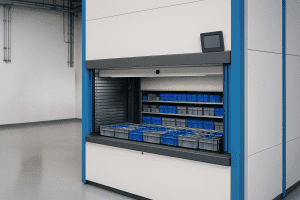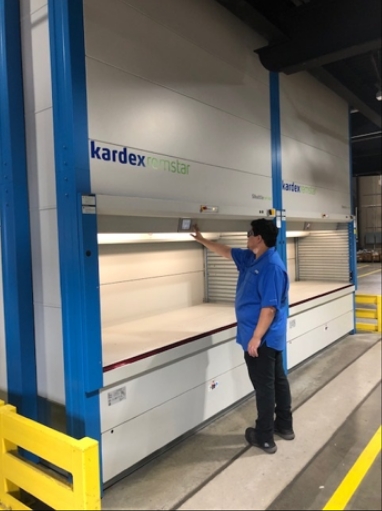Warehouse efficiency depends on more than just good processes—your storage system plays a central role in how quickly, accurately, and cost-effectively your operation runs. For most facilities, this comes down to choosing between two core options: traditional pallet racking or automated shelving systems like Vertical Lift Modules.
While pallet racking has long been a staple in warehouses, automation is gaining momentum. In this guide, we’ll help you determine which solution makes the most sense for your operation—or if a hybrid approach is your best bet.
What Is Pallet Racking?
Pallet racking is a static storage system designed for storing large quantities of palletized inventory. These systems typically include:
Selective racking for direct access to every pallet
Drive-in or drive-through racks for high-density storage
Push-back and pallet flow systems for optimized throughput
Cantilever racks for long or bulky items like steel tubes or lumber
Pallet racks are commonly used in facilities that handle full pallet loads, especially where storage density isn’t a major concern or space is plentiful.
If you’re evaluating or sourcing pallet rack systems, Cranston Material Handling is a trusted provider with decades of experience supplying industrial racking and storage equipment.
Benefits of pallet racking include:
Cost-effective upfront
Widely available
Compatible with forklifts and pallet jacks
Easy to understand and operate
However, pallet racking takes up a lot of floor space and can lead to inefficiencies when handling small parts, high SKU counts, or fast-pick orders.
What Are Automated Shelving Systems?
Automated shelving systems are modern, computer-controlled storage units that retrieve inventory automatically and deliver it directly to the operator. These systems fall under the umbrella of automated storage and retrieval systems (AS/RS).
Common examples include:
Robotic storage systems like RackBot ASRS
These systems are ideal for high-density storage in tight footprints and are particularly useful in industries like aerospace, medical device, electronics, and pharmaceuticals.
Space Utilization: Floor vs. Vertical
Space is often the biggest constraint in warehouse design. With pallet racking, you’re limited by your building’s footprint. Forklifts need wide aisles to navigate, and inventory is typically stacked just a few levels high.
By contrast, automated vertical storage systems like VLMs make full use of overhead space. Many reach 20–40 feet tall, with items automatically retrieved and presented to the operator at a central access point.
Result:
Automated systems can recover up to 90% of your floor space, freeing up room for packaging, staging, or growth—without expanding your building.
Labor Efficiency and Productivity
In traditional racking systems, employees often spend 60% or more of their time walking between shelves or operating equipment. This not only adds labor costs but also introduces risk of injury and error.
With automation, you implement a goods-to-person strategy that eliminates wasted movement. Items are delivered directly to the operator—often assisted by light-directed picking systems, barcode scanners, or touchscreens for maximum speed and accuracy.
Facilities using vertical carousels or VLMs often double or even triple their order picking output while reducing labor hours.
Inventory Accuracy and Traceability
Manual processes increase the chance of mispicks, misplaced inventory, and inconsistent tracking. In contrast, automated storage systems are software-controlled, offering:
Real-time inventory updates
Access control by user
Full audit logs of picks, returns, and inventory movement
This is especially beneficial in regulated environments or when handling serialized or lot-controlled items.
Cost and ROI
Pallet Racking:
Low cost upfront
Minimal technology needed
But may require future expansion
Automated Shelving Systems:
Higher upfront investment
Fast ROI from labor, space, and error reduction
Deferred need for new facilities
To better understand your potential savings, use our ROI calculator for vertical lift modules and other AS/RS solutions.
Versatility and Scalability
Pallet racking is modular, but each expansion requires additional floor space. You’re also limited in how much vertical space you can safely use.
Automated shelving offers dynamic tray configurations, adjustable software settings, and high scalability—without adding square footage. As your SKU count grows, simply add more VLM towers or stack systems vertically.
Plus, many of these systems can be relocated or reconfigured as your facility evolves.
Who Should Use Pallet Racking?
Warehouses with large quantities of palletized goods
Operations with slow-moving inventory
Facilities with lower pick rates and more open space
Tight budgets or short-term storage needs
For many companies, pallet racking is a necessary foundation—especially for reserve inventory, inbound shipments, or full pallet fulfillment.
Who Should Use Automated Shelving?
Companies with thousands of SKUs or high pick rates
Facilities dealing with labor shortages or rising costs
Businesses needing precise inventory control
Warehouses operating in expensive or tight urban spaces
Industries like aerospace, electronics, defense, and pharma have already made automated vertical storage their standard.
Hybrid Storage Strategies
You don’t have to choose one or the other. A hybrid approach—combining pallet racking with automated shelving—lets you optimize each zone based on item type, pick velocity, and floor space.
For example:
Use VLMs for small, fast-moving SKUs
Reserve racking for bulk stock, staging, or oversized goods
Add mobile aisle storage where density matters
For companies looking to upgrade or expand their pallet rack infrastructure as part of a hybrid setup, Cranston Material Handling offers a wide range of racking solutions tailored to warehouse needs.
Used Equipment Options
Worried about cost? Explore our used vertical lift modules or used vertical carousels for a budget-friendly way to automate your storage.
We even offer trade-in options and purchase pre-owned storage equipment from companies upgrading their systems.
Final Thoughts
Whether you’re expanding, optimizing, or just looking to solve a space challenge, the decision between pallet racking and automated shelving is significant—but it doesn’t have to be complicated.
Start with your goals:
Want more throughput with less labor? Go automated.
Need quick, low-cost implementation? Racking works.
Want both? We’ll help you design the right balance.
Get a Custom Storage Plan
At Vertical Storage USA, we specialize in helping warehouses optimize layout, workflow, and storage equipment for real ROI.
📞 Let’s talk about your needs.
👉 Contact us for a free consultation
Whether it’s a new VLM, used equipment, or a full redesign of your space—we’ll help you find the best fit.




